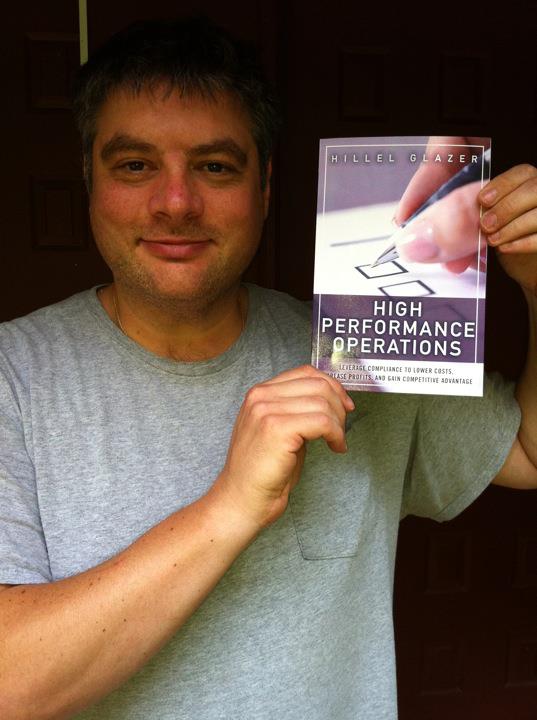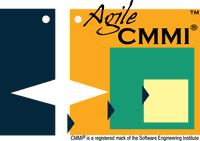High Performance Operations (my book) is now available!
Posted by agilecmmi on Oct 4, 2011 in Uncategorized | 1 comment
Why I wrote High Performance Operations…
This entry is a near-duplicate of the entry on my new site, hillelglazer.com. That site and the blog there are dedicated to a broader perspective within which this blog is a subset. The launch of that site and blog coincides with the publication of my new the book, High Performance Operations: Leverage Compliance to Lower Costs, Raise Profits, and Gain Competitive Advantage.
I figured I’d explain how and why I ended up writing the book.
What you see behind me is my office. This is where I “shoot” most of my blog entries, but I also shoot plenty of video from the field. At conferences, clients, and even from my car. Especially when the ideas are fresh in my mind and timely. My entries are rarely polished, seldom rehearsed, and typically WYSIWYG. Me.
I try to keep my content to topics that impact what we’re trying to do, and, with this site, blog and the book, we’re trying to affect change. We’re trying to help operations avoid having compliance issues drag them down in directions against their desired pursuits. We do this through several aspects of lean and excellence.
All things being equal, competing operations with similar market standings will end up fighting over a few percentage points in the noise. We want to help operations stand apart from the crowd by operating at a level of performance their competition won’t try to reach. One way to do this is to minimize, if not eliminate the burden of compliance on the operation. It just so happens that what it takes to do this also has an immediate and long-lasting positive impact on the entire operation, compliance or otherwise.
I hope you join in the discussion over there and find value in your participation.
You’ve got processes, but . . .
Posted by agilecmmi on Sep 23, 2011 in Appraisal, Generic Practices, Improvement, PDCA, SCAMPI, compliance | Comments Off
A friend who consults in program, project and risk management (typically to parachute-in and save wayward technology projects) is working with a client whose project is dreadfully behind schedule and over budget, and, not surprisingly, has yet to deliver anything the end-client or their users can put their hands on. It doesn’t help that his client isn’t actually known for being technology heroes. In fact, this is not the first time his client has tried to get this project off the ground.
Looking everywhere but in the mirror, my buddy’s client decided to have the developer put under a microscope. After all, reasoned the client, they hired the developer on, among other attributes, touts that they were rated at CMMI Maturity Level 3! So, they had the developer and the product undergo a series of evaluations (read: witch hunts) including a SCAMPI (CMMI) appraisal. Sadly, this tactic isn’t unusual.
Afterwards, trying to help his client make sense of the results, my pal asked me to review the report of the appraisal which was fairly and (more or less) accurately performed by someone else (not us). The appraisal was quite detailed and revealed something very interesting.
Lo-and-behold, the company had processes!
However, the development organization nonetheless failed to demonstrate the necessary performance of the Maturity Level 3 (ML3) practices they were claiming they operated with! In other words, they had processes, but they were still not ML3! In fact, they weren’t even Maturity Level 2 (ML2)!
How could this be?
While the details bore some very acute issues, what was more interesting were the general observations easily discernable from far away and with little additional digging. The appraisal company created a colorful chart depicting the performance of each of the practices in all of ML3. And, as I noted, there were important practices in particular areas with issues that would have precluded the achievement of ML2 or ML3; but, what was more interesting were the practices that were consistently poor, in all areas as well as the practices that were consistently strong in all areas.
One thing was very obvious: the organization, did, in fact, have many processes. Most of the processes one would expect to see from a CMMI ML3 operation. And, according to the report, they even had tangible examples of planning and using their practices.
What could possibly be going on here?
Seems awfully much like the development group had and used processes. How could they not rate better than Maturity Level 1 (ML1)?! Setting aside the specific gaps in some practices that would have sunk their ability to demonstrate anything higher than ML1 – because this isn’t where the interesting stuff shows up, and, because even were these practices performed, they still would have rated under ML2 – what the report’s colorful depiction communicated was something far harder to address than specific gaps. The developers’ organization was using CMMI incorrectly. A topic I cover at least in the following posts: here and here.
In particular, they were using CMMI to “comply” with their processes but not to improve their processes. And, *that* is what caused them to fall far short of their acclaimed CMMI ML3.
How could I tell?
Because of where the practices were consistently good and where they were consistently gap-worthy.
I was reviewing the report with my friend on the phone. As I was doing so he commented, “Wow! You’re reading that table like a radiologist reads an X-ray! That’s very cool!” The story the chart told me was that despite having processes, and policies, and managing requirements and so on, the company habitually failed to:
track and measure the execution of their processes to ensure that the processes actually were followed-through as expected from a time and resource perspective,
objectively evaluate that the processes were being followed, were working, and were producing the expected results, and
perform retrospectives on what they could learn from the measurements (they weren’t taking) and evaluations (they weren’t doing) of the processes they used.
It was quite clear.
So, here’s the point of today’s post… it’s a crystal clear example of why CMMI is not about process compliance and how it shows up. There are practices in CMMI that definitely help an organization perform better. But, if the practices that are there to ensure that the processes are working and the lessons are being learned aren’t performed, then the entire point to following a process has been lost. In Shewart’s cycle, this would be akin to doing P & D without C & A.
The only chance of anything that way is compliance. There’s no chance for improvement that way except by accident.
CMMI is not about “improvement by accident”. (Neither is Agile for that matter.)
Interestingly enough, while there were clearly issues with the developer’s commitment to improvement, there may not necessarily have been any clear issues with either the product or the results of their processes. While the experience may not have been pleasant for the developer, I don’t know that by buddy’s client can say to have found a smoking gun in their supplier’s hands. Maybe what the client needs is a dose of improving how they buy technology services – which they might find in CMMI for Acquisition.
Book Reviewers needed for High Performance Operations
Posted by agilecmmi on Aug 22, 2011 in Uncategorized | Comments Off
Greetings!
In the midst of wrapping up a personally taxing week this past Friday, I was greeted by an entirely surprising event: A box with a small shipment of Advance Reader’s copies of my book arrived! High Performance Operations: Leverage Compliance to Lower Costs, Raise Profits, and Gain Competitive Advantage. You can read more about it here: http://amzn.com/0132779889
I’m looking for a few folks to read and honestly review it in preparation of launch in about 6 weeks.
People whose work are related to Operations Management, Lean Enterprises, Performance Management, and similar fields will be right for this work. I only have about half a dozen printed Advance Reader’s copies and I would like to send one to people open to reading it and writing a review on their own personal/professional blogs as well as on Amazon. (Sorry, I don’t have e-book versions and *wish* I did!)
If you are or know someone who would be open to this, please read on and then please contact me via the contact form here.
Since we only have a limited number of copies, we’re going to accept “applications” for readers to qualify them to receive a copy.
When completing the contact form, you can leave the checkboxes blank, but in the open text field, (if you are filling this out for yourselves) please include your blog URL, twitter ID, and any other pointers to writing you’ve done. Also, be sure to tell me about yourselves and why you’re the right person to review and write about a book of this topic. (I’ll assume you’ve read the preview information at the Amazon link, above.)
Remember, I’ve only got about a half-dozen copies to distribute, so we want to put these precious few copies into the right hands. If you’re referring us to someone, please give them all this information, or, give us enough information so we can reach out to them.
So, if you’re still reading, I believe whoever reads the book will find it very relevant to their work (regardless of whether or not they deal with matters of ‘compliance’). One of my earlier reviewers who works for Goldratt’s company called it “a wolf in sheep’s clothing”.
The book is officially set to launch on October 9th. It may come sooner, but I still need to get that sorted out. It would help us out if you wrote an honest review of High Performance Operations sometime during that week (ideally launch day). Should you blog, please include a link to http://www.hillelglazer.com/ which will be revised and re-launched that day as well. (It’s not ready yet.)
If you don’t mind, optionally include the same Amazon link, http://amzn.com/0132779889 in any blog postings.
If you choose to also post a review on Amazon, you won’t be able to do that until launch day. I’ll update those who receive a book with the exact date as more information becomes available.
Please mention @hi11e1 anytime you tweet about the book or your reviews of it.
Oh, if we accept your application to read and write a review, you’re accepting a free book from me. Doing so, you acknowledge your understanding of the FTC Guides regarding endorsements. Specifically, you agree to disclose in your blog (and Amazon review, if you write one) that you received a free advanced copy of the book, and you agree that your statements will be your honest opinions of the book.
Everyone who qualifies, receives an Advance Reader’s copy of the book, and writes a review will receive a signed copy of the fully published hard-copy of the book after it launches!
Still interested?
Please contact me and we’ll get copies out during the week of 29 August.






